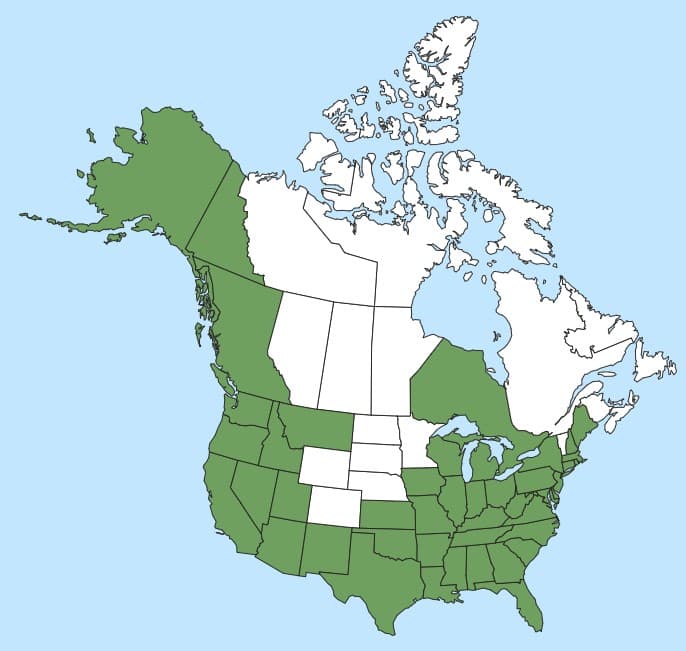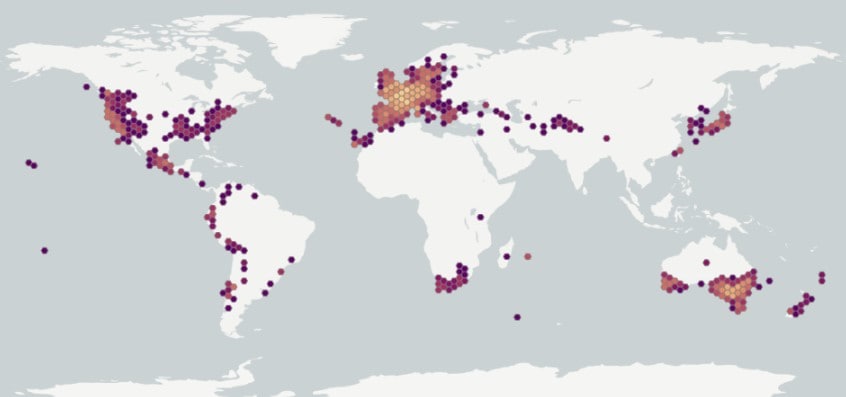Festuca myuros
Explore More :
Explore plus :
Overview
Aperçu
Regulation :
Remarques Réglementation:
Regulation Notes:
Distribution :
Répartition :
Festuca myuros is an annual grass believed to be native to almost all of Western Europe, the Mediterranean basin, Northern Africa, Western and Middle Asia, and the Indian Subcontinent (USDA-ARS 2023).
Festuca myuros has been widely introduced and naturalized in Southern Africa, Eastern and Northern Europe, Australasia, China, Taiwan, Japan, North America, South America, Central America, the Caribbean, and the sub-Antarctic islands (Büchi et al. 2020; USDA-ARS 2023; GOERT n.d.). It is listed as a problematic invasive grass weed in the southern and eastern Cape regions of South Africa, and temperate regions of Australasia (Büchi et al. 2020). In North America, F. myuros is naturalized throughout the continental United States except for the central region and in British Columbia, Ontario and the Yukon in Canada (Barkworth et al. 2007; USDA-ARS 2023).
Habitat and Crop Association :
Habitat et Cultures Associées :
Festuca myuros commonly grows in dry ruderal sites on sand and gravel banks, along roadsides and embankments, grasslands, salt marshes, open forests, meadows, coastal dunes, riparian lands, chaparral, pastures, disturbed habitats, and waste lands, usually on acidic soils (DiTomaso and Healy 2007; Weber 2017; Büchi et al. 2020; CABI 2023; GOERT n.d.).
Festuca myuros is a weed in pastures, grass seed production fields, and in no- or low-till and direct seeded cropping systems, such as used for Brassica napus (oil seed rape) and winter cereals, especially Triticum aestivum subsp. aestivum (winter wheat) (Alderman et al. 2011; Lyon et al. 2018; Akhter et al. 2020; Büchi et al. 2020; CABI 2023).
Fast-growing F. myuros can supress native species and dominate an area as it can out compete the slower-growing native perennial grasses (CABI 2023; GOERT n. d.). Elymus glaucus (blue wildrye), Hordeum brachyantherum (meadow barley), Koeleria macrantha (junegrass), Melica californica (California medic), and Nassella pulchra (purple stipa) are some of the native grass species in the western United States under threat from F. myuros (CABI 2023).
Economic Use, cultivation area, and Weed Association :
Utilisation économique, zone de culture et association de mauvaises herbes :
In the United States, F. myuros variety ‘Zorro’ is sold commercially (Alderson and Sharp 1995). It is an aggressive, early maturing annual grass, known for superior seedling establishment and is intentionally planted for revegetation of disturbed areas and wildfire burn scars, mine reclamation, erosion control, and as a cover crop in vineyards and orchards (Alderson and Sharp 1995; DiTomaso and Healy 2007; Weber 2017; Büchi et al. 2020). In Japan and China, it is used as a ground cover in vineyards and orchards (Büchi et al. 2020).
Duration of Life Cycle :
Durée du cycle vital:
Annual
Dispersal Unit Type :
Type d’unité de dispersion :
Floret
General Information
RENSEIGNEMENTS GÉNÉRAUX
Festuca myuros mainly behaves as a winter annual weed, although spring germination is not uncommon (Akhter et al. 2020). This species has a short seed dormancy period and the ability to survive harsh winters, contributing to its weediness in winter crops (Akhter et al. 2020; Büchi et al. 2020). Allelopathic compounds produced by living F. myuros plants as well as the toxic residues from decaying plants negatively affects germination and growth of crops and native plants (CABI 2023).
F. myuros seeds generally survive about one year if remaining on the soil surface and can survive two to three years if buried (DiTomaso and Healy 2007; Lyon et al. 2018; Akhter et al. 2020; GOERT n.d.). Seeds are mainly dispersed by attaching to animals, human clothing, and equipment (Weber 2017; Akhter et al. 2020; GOERT n. d.).
Festuca myuros provides poor quality grass forage for livestock because the mature florets are sharp pointed and can injure the mouths, nostrils, and eyes of grazing animals (DiTomaso and Healy 2007).
Note: Some authors separate the genus Vulpia from Festuca because this group of plants usually have an annual life cycle duration, a single stamen per flower, and the tendency for self-pollination (cleistogamous); whereas, Festuca plants usually have a perennial life cycle duration, three stamens per flower, and are open-pollinated (chasmogamous). Plants traditionally assigned to the genus Vulpia have also been placed under the genus Festuca by some authors and are currently treated under this genus in the GRIN database and by the AOSA Rules (AOSA 2022; USDA-ARS 2023).
.Identification
Identification
-
Spikelet
Size
- Spikelet length: 5 – 13 mm (excluding awns) (Tutin et al. 1980; Sharp and Simon 2002; Barkworth et al. 2007; Baldwin et al. 2012).
Spikelet size measurements from the literature:
• Spikelet length: 6 – 10.5 mm (excluding awns); spikelet composition: 2-5 fertile florets and 1-2 distal sterile or male florets (Tutin et al. 1980).
• Spikelet length: 7 – 13 mm; spikelet composition: 3 – 10 florets (Sharp and Simon 2002).
• Spikelet length: 5 – 12 mm; spikelet composition: 3 – 7 florets (Barkworth et al. 2007).
• Spikelet length: 5 – 11.5 mm (Baldwin et al. 2012).Shape
- Spikelet oblong, laterally compressed.
Surface Texture
- Spikelet surface thin and papery and may have some short or long hairs.
Colour
- Spikelet pale yellowish brown coloured.
Other Features
Spikelet composition
- Spikelet composed of 3 – 10 similar looking florets, distal florets usually reduced in size and staminate or sterile (Tutin et al. 1980; Sharp and Simon 2002).
Glumes
- Lower glume 0.4 – 2.5 mm, one-tenth to two-fifths as long as upper glume; upper glume length: 2.5 – 6.5 mm (including awn up to 1 mm long) (Tutin et al. 1980).
Spikelet disarticulation
- Disarticulation of the spikelet occurs generally above the glumes and between the florets at the rachilla nodes.
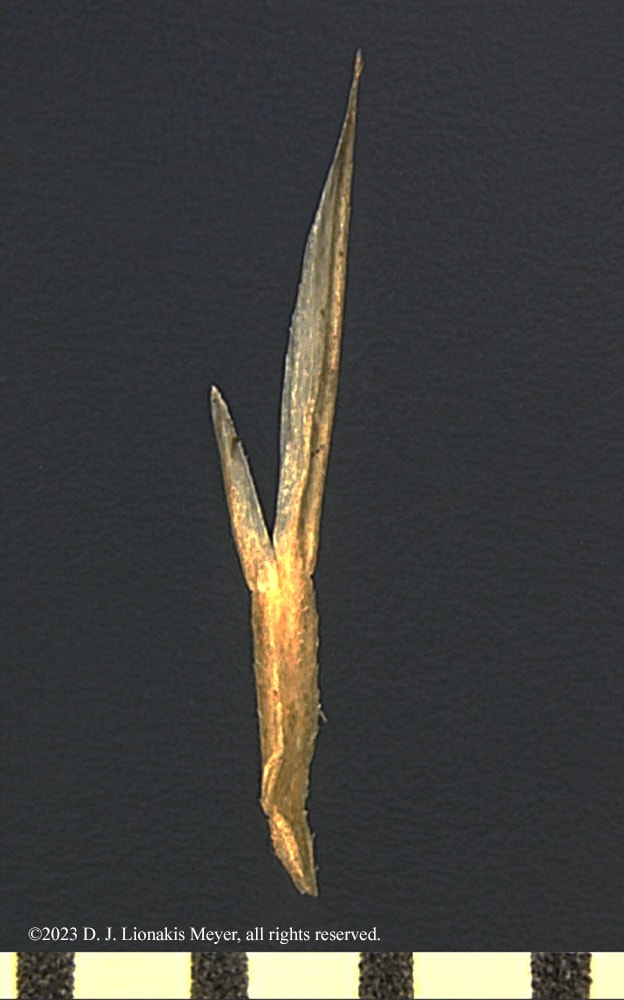
Festuca myuros (rattail fescue) glumes and attached pedicel; in this species the lower glume is less than one-half the length of the upper glume. [Vulpia myuros] Scale in mm

-
Floret
Size
- Floret length*: 5.5 – 6.9 mm (average 6.4 mm); width*: 0.4 – 0.7 mm (average 0.5 mm)
- Awn length*: 5.0 – 13.1 mm (average 10.6 mm)
- Rachilla length*: 0.8 – 1.0 mm (average 0.9 mm)
*Note: minimum and maximum based on a random selection of 20 florets in normal range of this species using image measurement protocol (ISMA 2020). CDA-S-23329 and CDA-S-23337.
Floret size measurements from the literature:
• Lemma length 4.5 – 7.5 mm; width 0.8 – 1.3 mm; awn usually 1 – 2 times as long as lemma (Tutin et al. 1980).
• Lemma length 4.5 – 5 mm; width about 0.5 mm; awn usually 1.5 – 2.5 times as long as lemma (Bojňanský and Fargašová 2007).
• Lemma length 4.7 – 8.5 mm; awn length 5 – 19.6 mm; rachilla length 0.9 – 1.9 mm (Sharp and Simon 2002).
• Lemma length 4.5 – 7 mm; awn length 5 – 15(22) mm; rachilla length 0.75 – 1(1.9) mm (Barkworth et al. 2007).
• Lemma length 4.5 – 6.5 mm; awn length 5 – 15 mm (Baldwin et al. 2012).Shape
- Floret linear to very narrowly teardrop shaped (very narrowly lanceolate), dorsal-ventrally compressed and in-rolled.
Surface Texture
- Lemma thin and papery.
- Palea membranous and nearly transparent.
Colour
- Floret pale yellowish-brown coloured, sometimes with purple tinge.
Other Features
Lemma
- Lemma tapered and extending into a long, straight awn.
- Lemma generally wraps around and covers the margins of the palea but usually leaving the palea keels exposed.
- Lemma 5-nerved.
- Lemma smooth to covered with short stiff hairs, the margins of the upper half of lemma may have a row of long straight hairs.
Awn
- Awn long and straight.
- Awn covered with short stiff hairs.
Callus
- Callus glabrous.
- Callus narrow at outer edges and thicker in the center, looking like a gently rounded point.
- Callus about 0.2 mm long (Tutin et al. 1980).
Rachilla
- Rachilla thin, cylindrical and usually sparsely covered with short stiff hairs.
Palea
- Palea slightly shorter than lemma.
- Palea nearly transparent with caryopsis visible through palea, although lemma and palea in-rolled concealing view of caryopsis.
- Palea slightly grainy textured between keels.
- Keel hairs (palea teeth) evenly spaced, short and stiff with broad base tapering to point, usually the same length all the way to the palea tip.
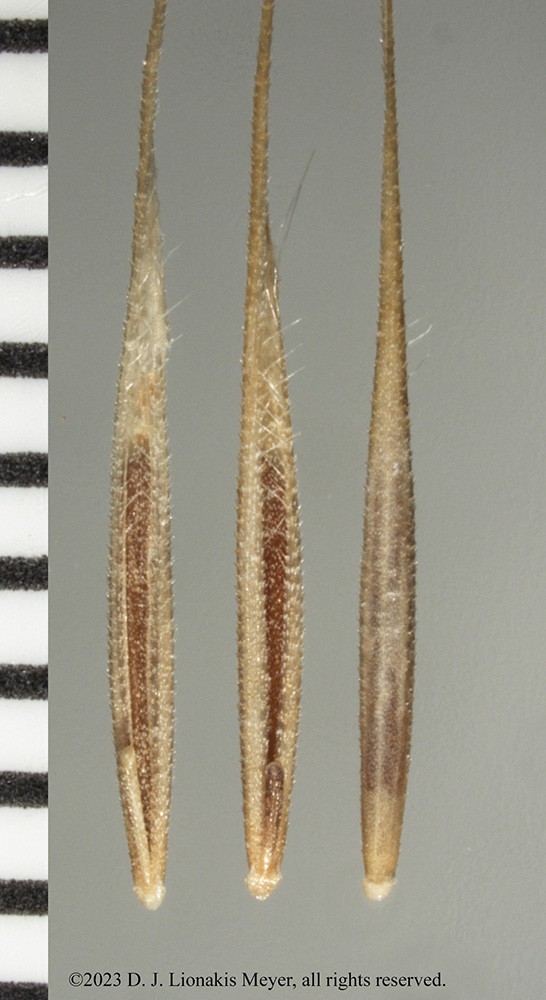
Festuca myuros (rattail fescue) floret lemma margins with long ciliate hairs. [Vulpia myuros] Scale in mm

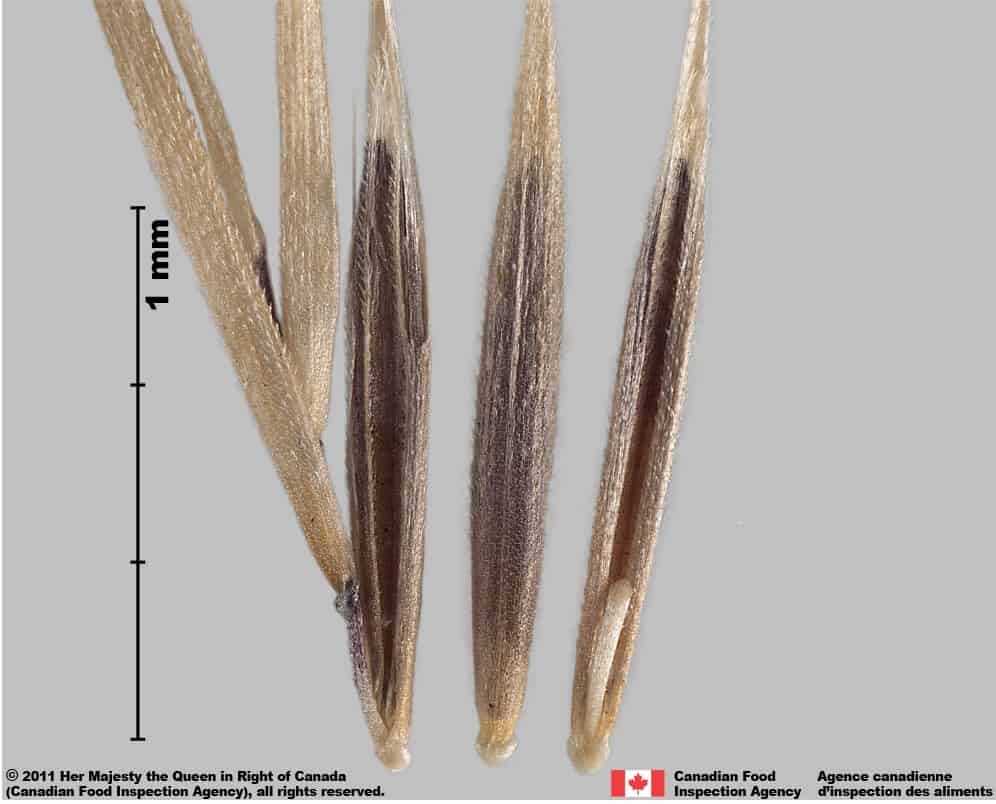
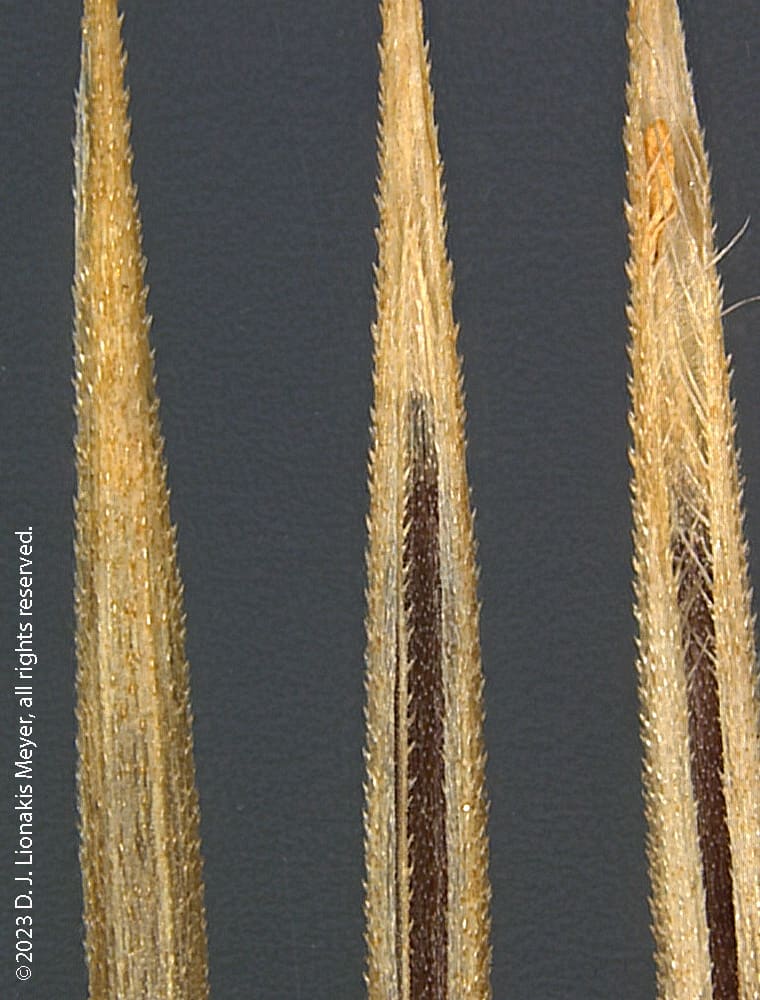
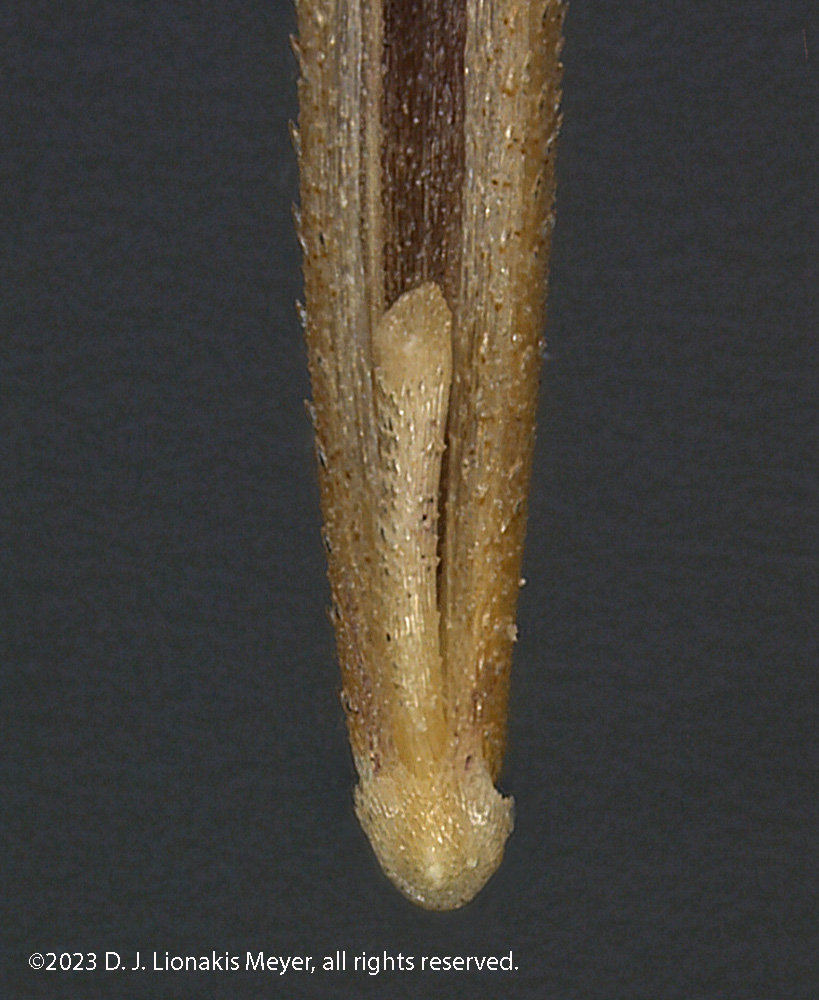
-
Caryopsis
Size
- Caryopsis length*: 3.2 – 4.5 mm (average 4.0 mm); width*: 0.5 – 0.6 mm (average 0.6mm)
- Hilum length*: 2.2 – 3.5 mm (average 2.9 mm)
*Note: minimum and maximum based a random selection of 10 caryopses in normal range of this species using image measurement protocol (ISMA 2020). CDA-S-45766.
Caryopsis size measurements from the literature:
• Caryopsis length 3.2 – 3.6 mm; width about 0.4 mm (Bojňanský and Fargašová 2007).
• Caryopsis length 3 – 5 mm (Barkworth et al. 2007).
• Caryopsis length 3.5 – 4.5 mm (Baldwin et al. 2012).Shape
- Caryopsis narrowly linear, pointed at embryo end, straight, dorsal-ventrally compressed, may be slightly in-rolled on hilum side forming a longitudinal depression.
Surface Texture
- Caryopsis surface smooth, dull to slightly shiny, the lemma and palea may be adherent.
Colour
- Caryopsis reddish-brown coloured.
Other Features
- Hilum linear, about three-quarters the length of the caryopsis, located in a longitudinal depression.
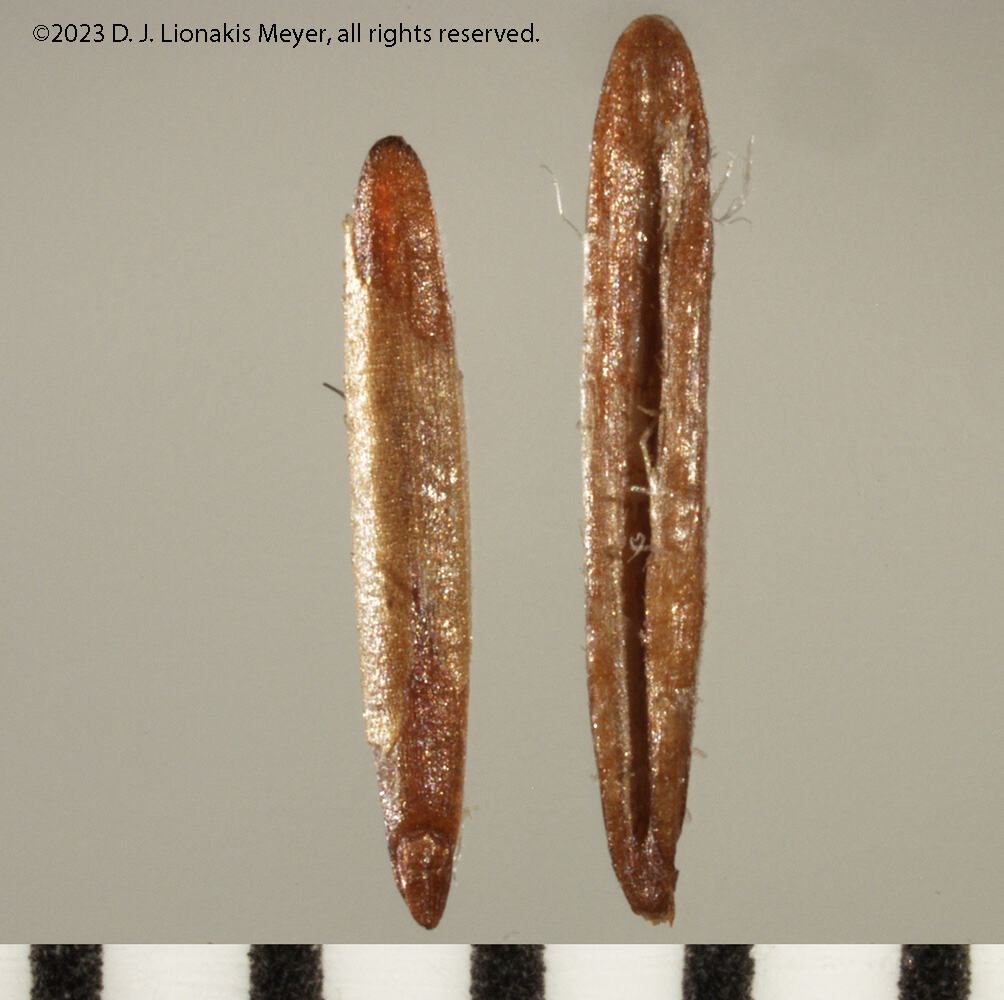
Festuca myuros (rattail fescue) caryopses, embryo view (left) and hilum view (right). [Vulpia myuros] Scale in mm

-
Embryo
Size
- Embryo length*: 0.4 – 0.7 mm (average 0.6 mm).
- Embryo about one-seventh the length of the caryopsis.
*Note: minimum and maximum based on a random selection of 10 embryos in normal range of this species using image measurement protocol (ISMA 2020). CDA-S-45766.
Shape
- Embryo narrowly teardrop shaped.
Endosperm
- Endosperm solid (Terrell 1971).
Other Features
- Embryo in lateral position (Martin 1946).

Festuca myuros (rattail fescue) caryopses, embryo view (left) and hilum view (right). [Vulpia myuros] Scale in mm

Identification Tips
CONSEILS POUR L’IDENTIFICATION
In seed testing, the three most commonly encountered annual species of Festuca are F. bromoides, F. myuros, and F. octoflora. Florets of F. myuros and F. bromoides are very similar looking and are often confused.
- The lower glume of Festuca myuros is usually less than one-half the length of the upper glume; whereas in F. bromoides the lower glume is one-half to three-quarters the length of the upper glume. Glume length is the single most important diagnostic character used to separate F. bromoides and F. myuros plants.
- Mature florets of F. myuros tend to be straight, while those of F. bromoides appear arched in lateral view.
- Florets of F. myuros and F. bromoides are larger in size than those of F. octoflora.
- The florets of F. myuros and F. bromoides are long and narrow, while those of F. octoflora are narrowly teardrop shaped.
- Margins of the upper half of lemma may have long straight hairs in F. myuros, while lemma margins of F. bromoides do not.
Refer to the comparison chart under the similar species section of this factsheet for detailed diagnostic features of these three species.

Festuca myuros (rattail fescue) glumes and attached pedicel; in this species the lower glume is less than one-half the length of the upper glume. [Vulpia myuros] Scale in mm






Additional Botany Information
AUTRES RENSEIGNEMENTS BOTANIQUES
Flowers/Inflorescence
- The inflorescence of Festuca myuros is usually an upright or slightly nodding panicle or spikelike raceme, 5 – 35 cm long and up to 2 cm wide (Tutin et al. 1980; Barkworth et al. 2007).
- The plants are usually self-pollinated (Barkworth et al. 2007; DiTomaso and Healy 2007).
Vegetative Features
- The stems of Festuca myuros are solitary or loosely tufted, 10 – 75 (90) cm tall (Barkworth et al. 2007).
- The root system is fibrous and usually shallow (Lyon et al. 2018; Akhter et al. 2020).
Similar Species
ESPÈCES SEMBLABLES
Similar species are based on a study of seed morphology of various species, and those with similar dispersal units are identified. The study is limited by physical specimen and literature availability at the time of examination, and possibly impacted by the subjectivity of the authors based on their knowledge and experience. Providing similar species information for seed identification is to make users aware of similarities that could possibly result in misidentification.
Festuca myuros and F. bromoides are commonly found as contaminants in seed lots. Festuca myuros is sometimes sold for erosion control (Alderson and Sharp 1995). Festuca octoflora is also marketed for erosion control (USDA-ARS 2023) but the florets of F. octoflora are generally smaller in size and have much shorter awns compared to F. myuros or F. bromoides. Refer to the comparison table for detailed diagnostic features of these three species.
Two other species native to North America may occasionally be encountered in seed samples; Festuca microstachys, native to western North America from British Columbia to Baja California, and Festuca sciurea, native to the southeastern region of the United States (Barkworth et al. 2007; USDA-NRCS 2023). Floret and glume lengths of F. microstachys are similar to those of F. myuros; however, depending on the botanical variety, florets and/or glumes of F. microstachys may be covered with hairs of various lengths or have no hairs (Barkworth et al. 2007). Festuca sciurea is generally smaller in size (lemma 2.5 – 3.5 mm; 3-nerved) and the hairs near the lemma tip are much longer (Barkworth et al. 2007).
Comparison table for mature floret and glume characters for Festuca myuros, F. bromoides, and F. octoflora. Measurements* shown are by first author using ISMA measurement protocol (2020).
| F. myuros | F. bromoides | F. octoflora | |
| Glumes | Lower glumes less than one-half the length of the upper glume | Lower glume one-half or more the length of upper glume | Lower glume one-half or more the length of upper glumes |
| Floret shape | Linear | Narrowly linear-teardrop shaped (narrowly lanceolate), dorsal-ventrally compressed; body straight or arched backward | Narrowly teardrop-shaped (lanceolate) |
| Floret length* | 5.5 – 6.9 mm (average 6.4 mm) | 4.1 – 7.7 mm (average 5.9 mm) | 2.5 – 4.7 mm (average 3.7 mm) |
| Floret width*
|
0.4 – 0.7 mm (average 0.5 mm) | 0.4 – 0.8 mm (average 0.6 mm) | 0.5 – 0.8 mm (average 0.6 mm) |
| Lemma surface texture and hairs | Mostly smooth to covered with short stiff hairs, the upper margins may have long hairs | Mostly smooth in lower one-third and covered with short stiff hairs in upper one-third to two-thirds | Depending on variety, smooth or covered with short stiff or longer soft hairs |
| Lemma awn length* | 5.0 – 13.1 mm (average 10.6 mm) | 2.8 – 13.3 mm (average 6.1 mm) | 0.6 – 2.8 mm (1.5 mm) |
| Callus | Smooth, without hairs, narrow at outer edges and thicker in center, looking like a gently rounded point | Smooth, without hairs, narrow at outer edges and thicker in center, looking like a gently rounded point | Blunt, narrow ridge, smooth in center and with short hairs at outer edges |
| Palea | Nearly transparent with caryopsis visible through palea; slightly grainy textured between keels | Palea tip usually flattened out; semi-transparent with caryopsis visible through palea; palea may be in-rolled concealing view of caryopsis; sparsely covered with short hairs between keels | Opaque to semi-transparent, grainy textured or sparsely covered with hairs between keels |
| Palea keel hairs (teeth) | Evenly spaced, short and stiff with broad base tapering to a point, hairs are same length all the way to the palea tip | Evenly spaced, short and stiff with broad base tapering to a point, hairs are longer near palea tip | Evenly spaced, short and stiff with broad base tapering to a point. |
| Caryopsis size* | 3.2 – 4.5 mm long; 0.5 – 0.6 mm wide | 2.6 – 4.8 mm long; 0.7 – 1.1 mm wide | 2.1 – 2.7 mm long; 0.5 – 0.7 mm wide |
| Hilum* | Linear; about three-quarters the length of the caryopsis | Linear; about nine-tenths the length of the caryopsis | Linear; slightly more than one-half the length of the caryopsis |
Click to select species
Cliquez pour sélectionner les espèces
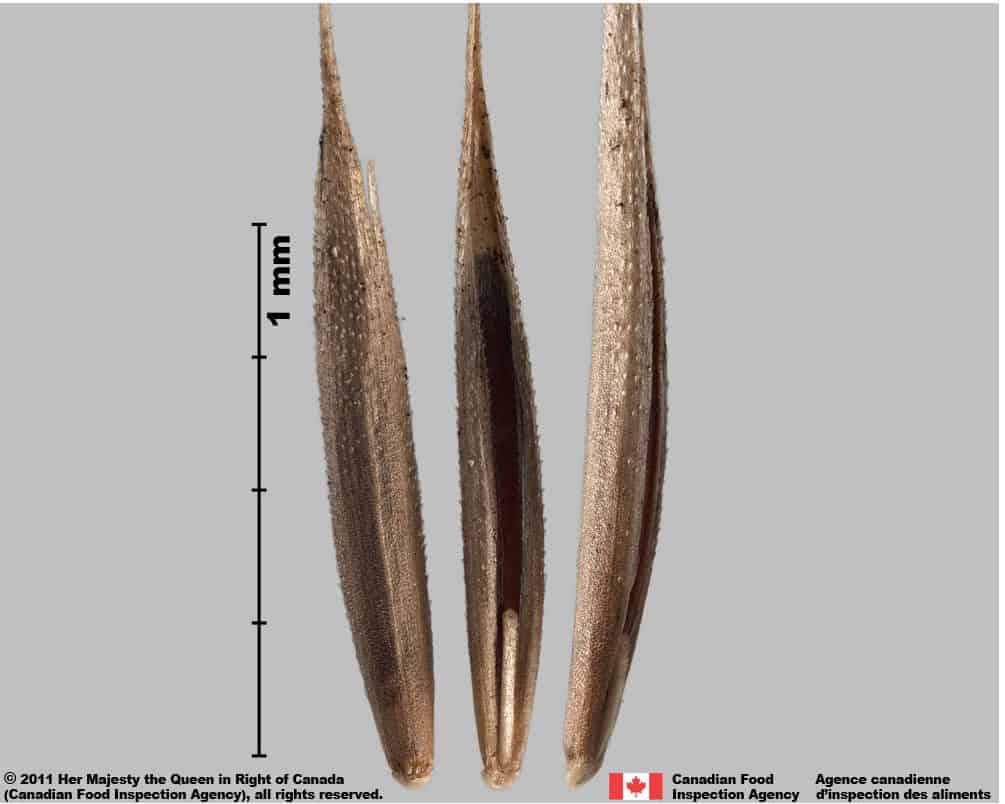
Festuca bromoides
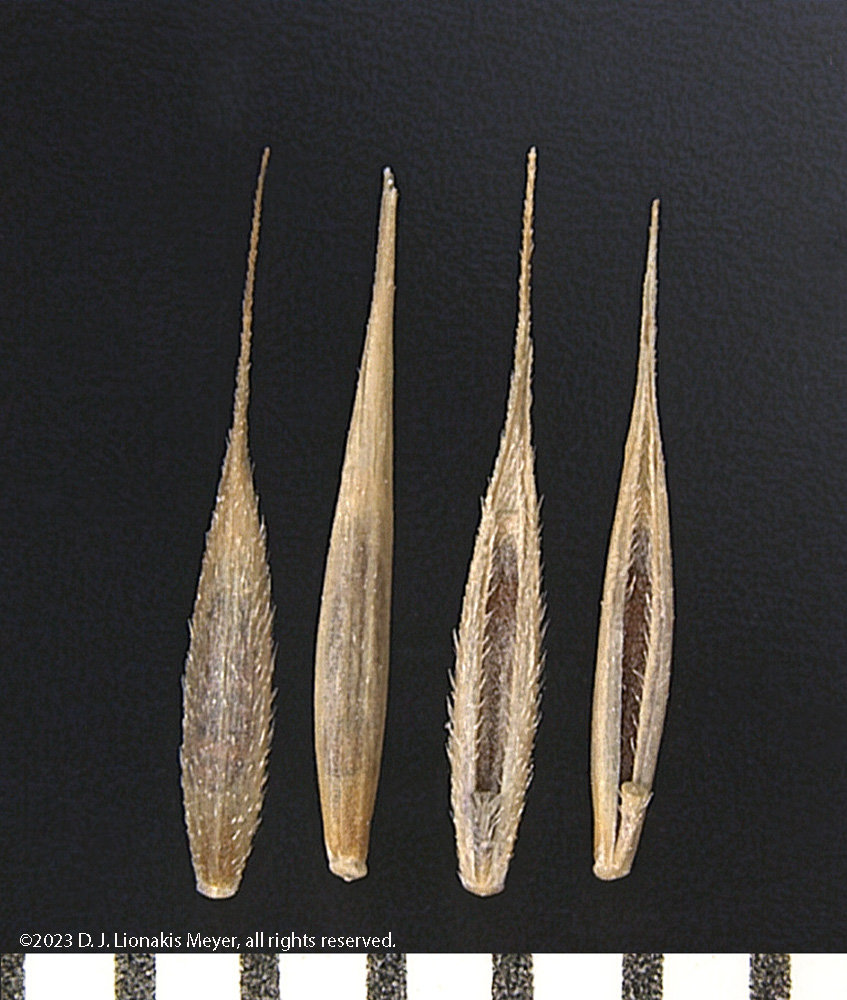
Festuca octoflora
Comparison Window
Fenêtre de comparaison
MAIN SPECIES
ESPÈCES PRINCIPALES
Festuca myuros

Festuca myuros
Poaceae
Festuca myuros (rattail fescue) florets
MAIN SPECIES
ESPÈCES PRINCIPALES
Festuca myuros

Festuca myuros
Poaceae
Festuca myuros (rattail fescue) floret lemma margins with long ciliate hairs. [Vulpia myuros] Scale in mm
MAIN SPECIES
ESPÈCES PRINCIPALES
Festuca myuros

Festuca myuros
Poaceae
Festuca myuros (rattail fescue) close-up of florets, lemma covered with short stiff hairs (left), lemma margins without ciliate hairs (middle), and lemma margins with long ciliate hairs. [Vulpia myuros]
MAIN SPECIES
ESPÈCES PRINCIPALES
Festuca myuros

Festuca myuros
Poaceae
Festuca myuros (rattail fescue) rachilla is thin and cylindrical and covered with short stiff hairs. [Vulpia myuros]
MAIN SPECIES
ESPÈCES PRINCIPALES
Festuca myuros

Festuca myuros
Poaceae
Festuca myuros (rattail fescue) glumes and attached pedicel; in this species the lower glume is less than one-half the length of the upper glume. [Vulpia myuros] Scale in mm
MAIN SPECIES
ESPÈCES PRINCIPALES
Festuca myuros

Festuca myuros
Poaceae
Festuca myuros (rattail fescue) caryopses, embryo view (left) and hilum view (right). [Vulpia myuros] Scale in mm
SIMILAR SPECIES
ESPÈCES SEMBLABLES
Festuca bromoides

Festuca bromoides
Poaceae
Festuca bromoides (brome fescue) florets
SIMILAR SPECIES
ESPÈCES SEMBLABLES
Festuca bromoides
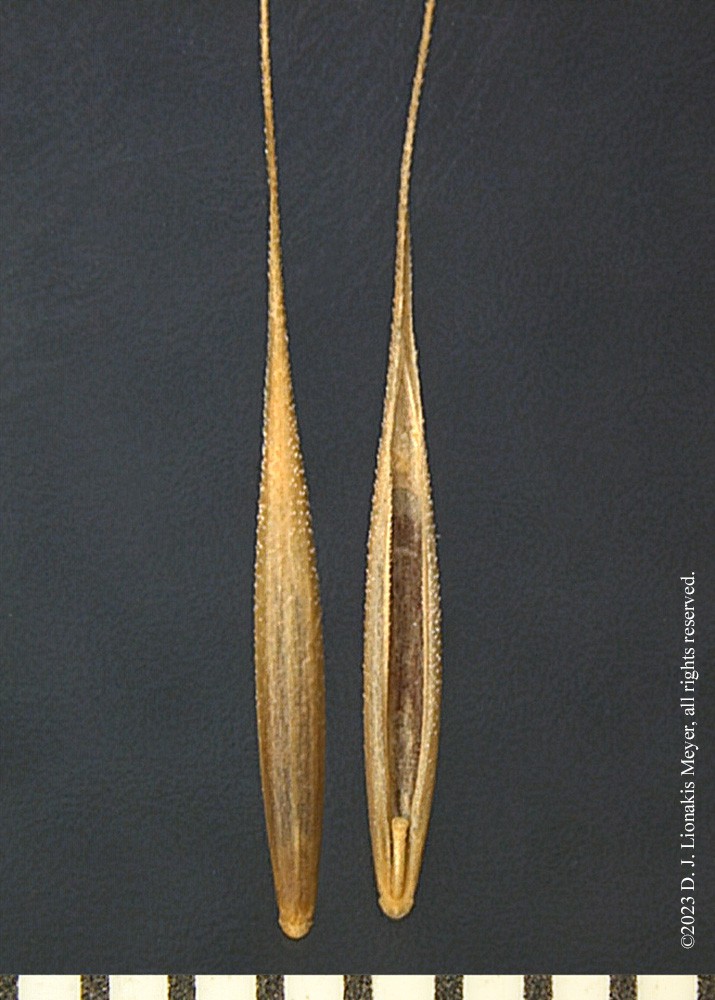
Festuca bromoides
Poaceae
Festuca bromoides (brome fescue) florets, lemma view (left) and palea view (right). [Vulpia bromoides] Scale in mm
SIMILAR SPECIES
ESPÈCES SEMBLABLES
Festuca bromoides
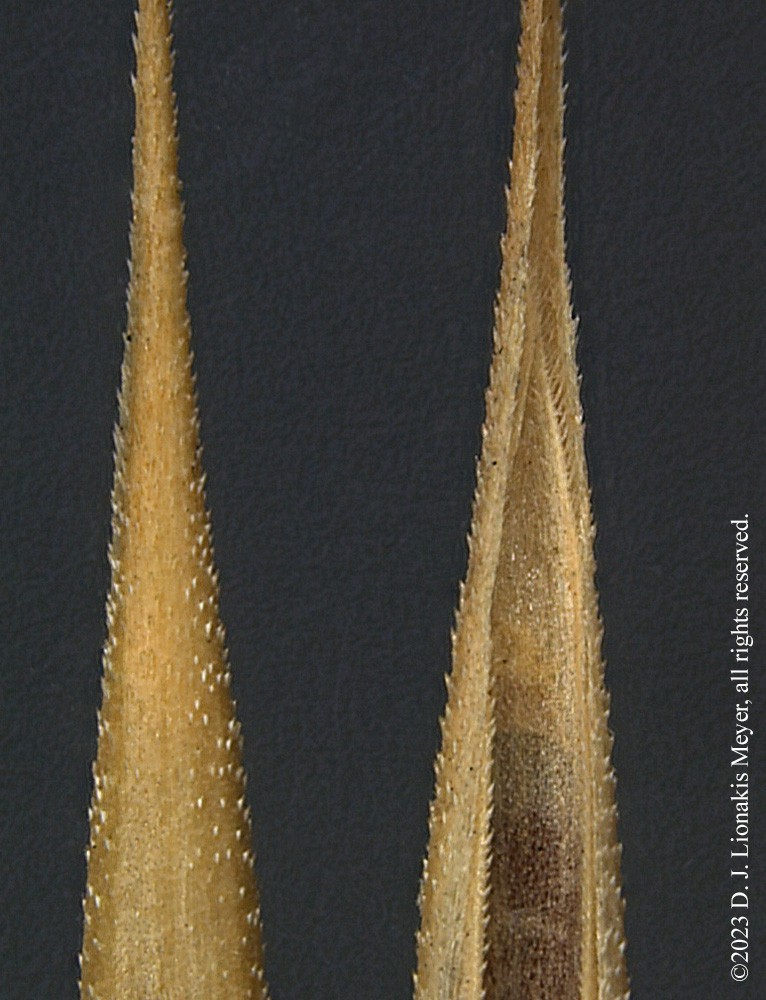
Festuca bromoides
Poaceae
Festuca bromoides (brome fescue) close-up view of florets showing surface texture detail. Lemma tip and base of awn (left) covered with short stiff hairs. Palea view (right) showing short stiff hairs (palea teeth) along the palea keels transitioning into longer and more closely spaced hairs near palea tip. [Vulpia bromoides]
SIMILAR SPECIES
ESPÈCES SEMBLABLES
Festuca bromoides
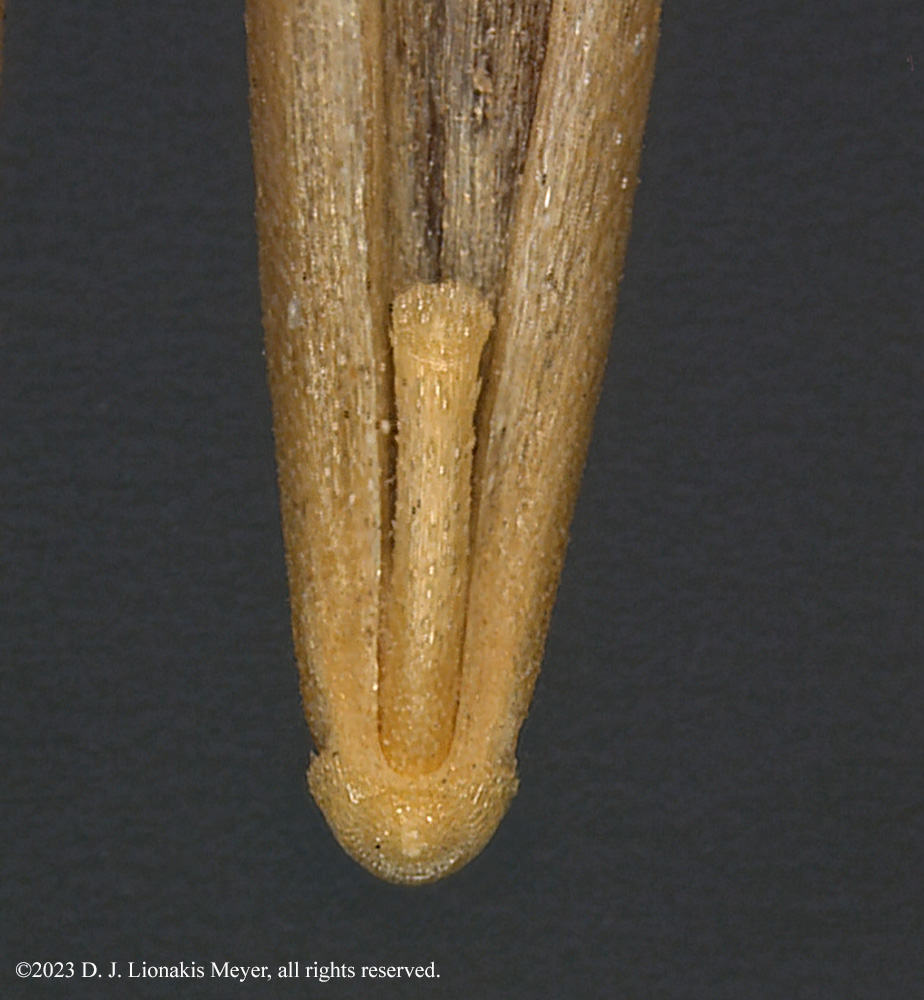
Festuca bromoides
Poaceae
Festuca bromoides (brome fescue) rachilla is thin and cylindrical and covered with short stiff hairs. [Vulpia bromoides]
SIMILAR SPECIES
ESPÈCES SEMBLABLES
Festuca bromoides
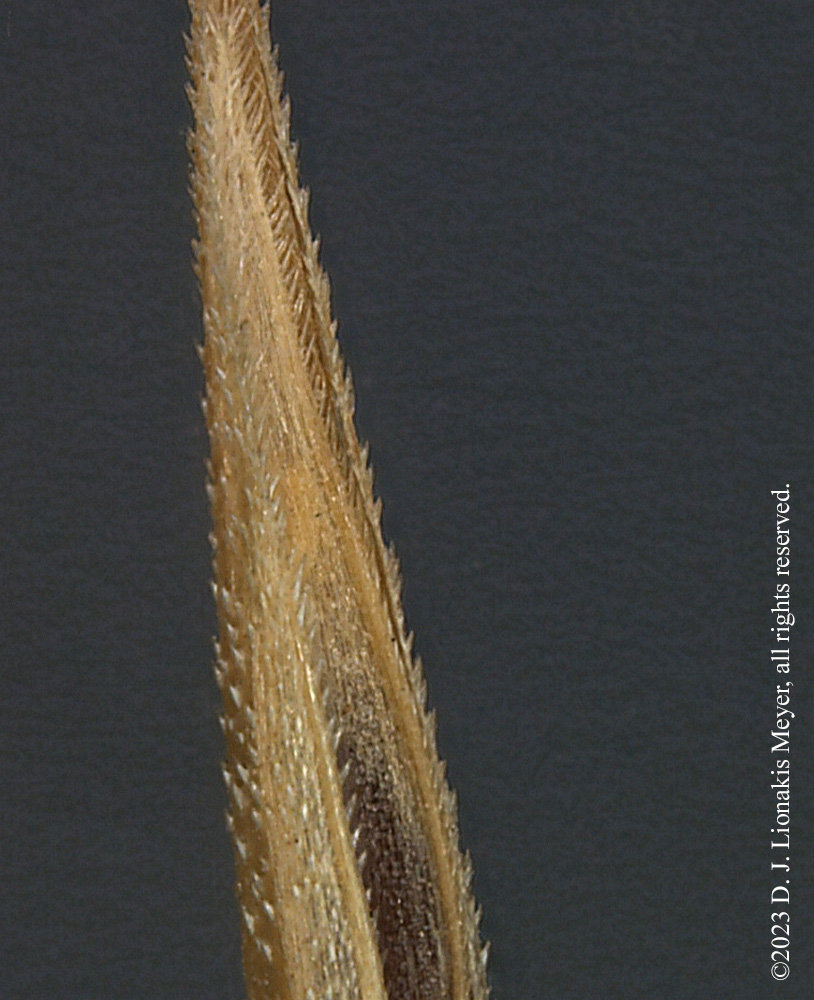
Festuca bromoides
Poaceae
Festuca bromoides (brome fescue) close-up view of palea showing short stiff hairs (palea teeth) along the exposed palea keels transitioning into longer and more closely spaced hairs near palea tip. [Vulpia bromoides]
SIMILAR SPECIES
ESPÈCES SEMBLABLES
Festuca bromoides
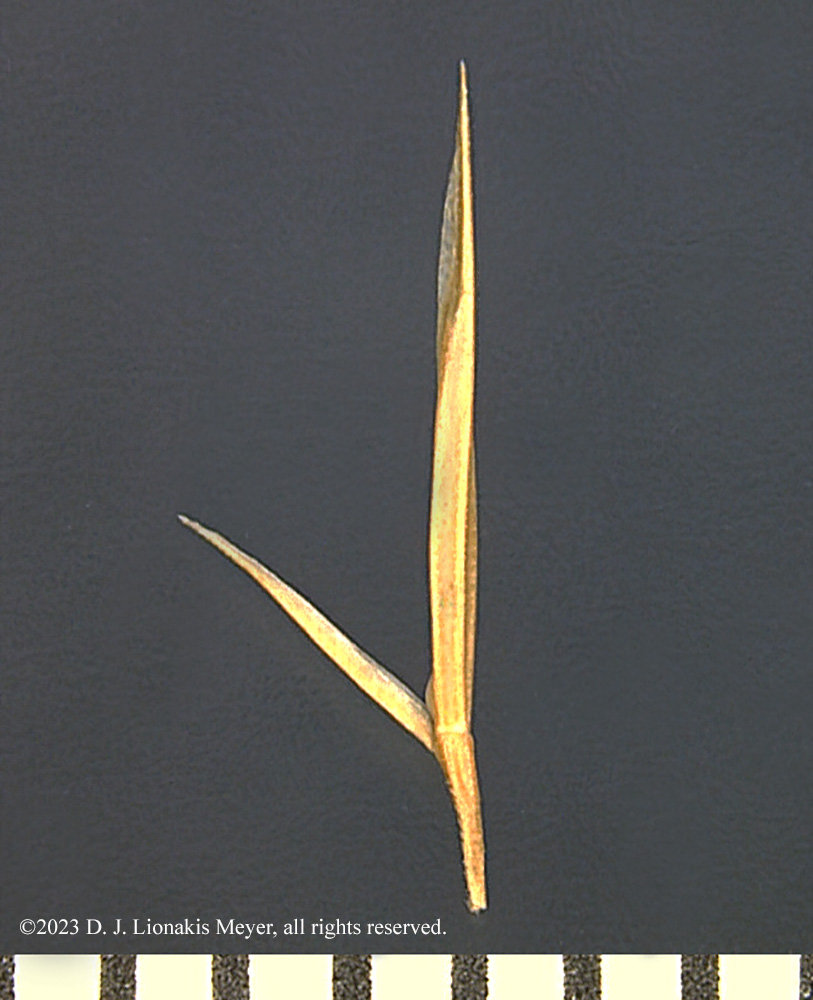
Festuca bromoides
Poaceae
Festuca bromoides (brome fescue) glumes and attached pedicel; in this species the lower glume is one-half or more the length of the upper glume. [Vulpia bromoides] Scale in mm
SIMILAR SPECIES
ESPÈCES SEMBLABLES
Festuca bromoides
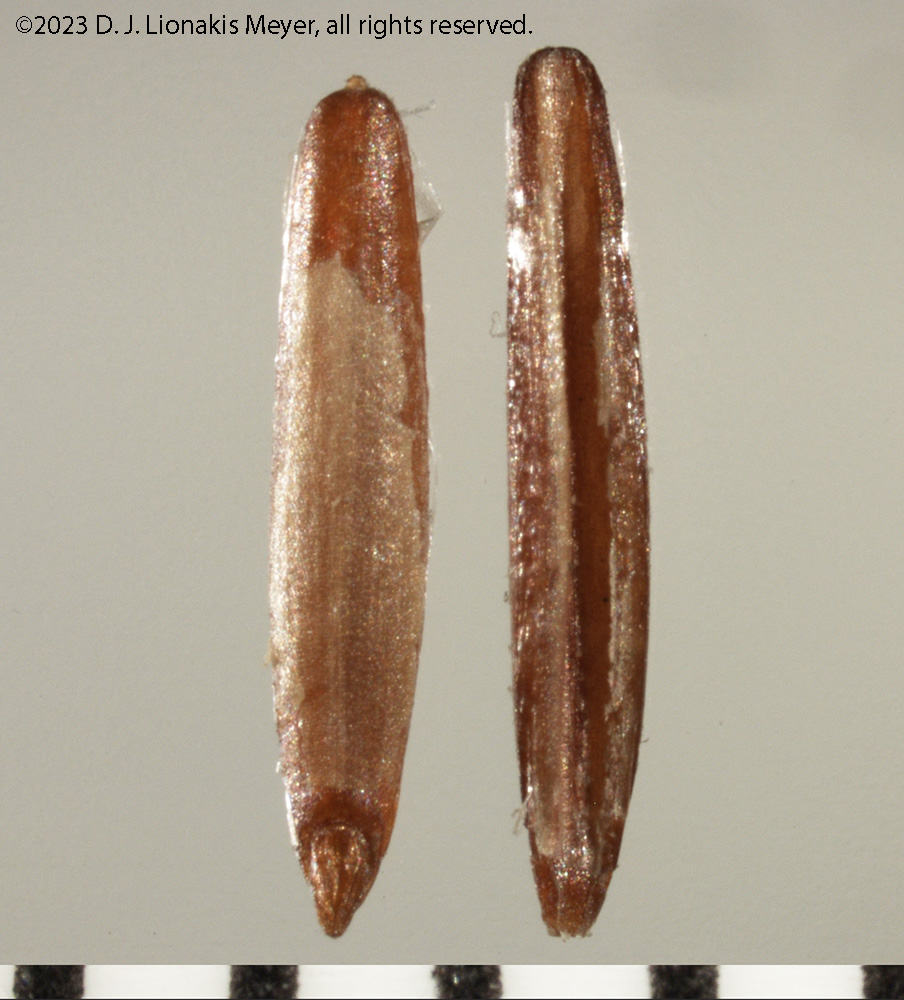
Festuca bromoides
Poaceae
Festuca bromoides (brome fescue) caryopses, embryo view (left) and hilum view (right). [Vulpia bromoides] Scale in mm
Need ID Help?
Besoin d’aide pour l’identification?
Reference(s)
Référence(s)
Akhter, M. J., Jensen, P. K., Matthiassen, S. K., Melander, B. & Kudsk, P. 2020. Biology and Management of Vulpia myuros—An Emerging Weed Problem in No-Till Cropping Systems in Europe. Plants (Basel) 9(6): 715-729. https://doi.org/10.3390/plants9060715.
Aldén, B., S. Ryman, & M. Hjertson. 2012. Svensk Kulturväxtdatabas, SKUD (Swedish Cultivated and Utility Plants Database; online resource) https://skud.slu.se/nav/taxa?epslanguage=sv&p=1282 Accessed January 28, 2023.
Alderman, S. C., Elias, S. G., Hulting, A. G. 2011. Occurrence and trends of weed seed contaminants in fine fescue seed lots in Oregon. Seed Technology 33(1):7-21.
Alderson, J. & W. C. Sharp. 1995. Grass varieties in the United States, U.S.D.A. Agric. Handbook 170, rev. ed. CRC Press.
Association of Official Seed Analysts (AOSA). 2022. Rules for Testing Seeds. Volume 3: Uniform Classification of Weed and Crop Seeds. Association of Official Seed Analysts, Washington DC.
Baldwin, B. G., Goldman, D. H., Keil, D. J., Patterson, R., Rosatti, T. J., Wilken, D. H. (Eds.). 2012. The Jepson Manual: Vascular Plants of California. 2nd edition. University of California Press, Berkeley, CA.
Barkworth, M. E., Capels, K. M., Long, S., and Piep, M. B. (Eds.). 2007. Flora of North America Volume 24. Magnoliophyta: Commelinidae (in part): Poaceae, part 1. Oxford University Press, New York, New York.
Bojňanský, V. and Fargašová, A. 2007. Atlas of Seeds and Fruits of Central and East-European Flora: The Carpathian Mountains Region. Springer, Dordrecht, The Netherlands.
Büchi, L., Cordeau, S., Hull, R. & Rodenburg, J. 2020. Vulpia myuros, an increasing threat for agriculture. Weed Research 61(1): pp.13-24. https://doi.org/10.1111/wre.12456.
Centre for Agriculture and Bioscience International (CABI). 2023. Invasive Species Compendium, CAB International, Wallingford, UK. Vulpia myuros (annual fescue) – Datasheet. https://www.cabi.org/isc/datasheet/117880. Accessed January 10, 2023.
DiTomaso, J. M. and Healy, E. A. 2007. Weeds of California and Other Western States. Vol. 2: Geraniaceae – Zygophyllaceae. Agriculture and Natural Resources Publication 3488. University of California, Oakland, CA.
eFloras. 2023. Flora of China. Vulpia myuros. http://www.efloras.org/florataxon.aspx?flora_id=2&taxon_id=220014224 Accessed January 10, 2023.
Garry Oak Ecosystems Recovery Team (GOERT), (n.d.). Vulpia bromoides & myuros. Invasive Species in Garry Oak and Associated Ecosystems in British Columbia. Garry Oak Ecosystems Recovery Team. https://goert.ca/wp/wp-content/uploads/IS-factsheet-vulpia-bromoides-myuros.pdf. Accessed January 20, 2023.
International Seed Morphology Association (ISMA). 2020. Method for seed size measurement. Version 1.0. ISMA Publication Guide.
Lyon, D. J., Ball, D. A. & Hulting, A. G. 2018. Rattail Fescue: Biology and Management. In: Pacific Northwest Wheat Cropping Systems. A Pacific Northwest Extension Publication. PNW613. https://pubs.extension.wsu.edu/rattail-fescue-biology-and-management-in-pacific-northwest-wheat-cropping-systems.
Martin, A. C. 1946. The comparative internal morphology of seeds. The American Midland Naturalist 36(3):513-660.
Sharp, D. and Simon, B.K. 2002. AusGrass: Grasses of Australia. CD-ROM, Version 1.0 (Australian Biological Resources Study, Canberra, and Environmental Protection Agency, Queensland). https://keys.lucidcentral.org/keys/v3/AusGrass/key/AusGrass/Media/Html/VULPIA/VULMYU.HTML Accessed January 17, 2023.
Terrell, E. E. 1971. Survey of occurrences of liquid or soft endosperm in grass genera. Bull. Torr. Botan. Club 98(5):264-268.
Tutin, T. G., Haywood, V. H., Burges, N. A., Moore, D. M., Valentine, D. H., Waters, S. M., Webb, D. A. (Eds.). 1980. Flora Europaea. Volume 5: Alismataceae to Orchidaceae (Monocotyledons). Cambridge University Press.
United States Department of Agriculture-Agricultural Research Services (USDA-ARS). 2023. Germplasm Resources Information Network (GRIN). http://npgsweb.ars-grin.gov/gringlobal/taxon/taxonomydetail?id=16682. Accessed January 10, 2023.
United States Department of Agriculture-Natural Resources Conservation Service (USDA-NRCS). 2023. The PLANTS Database. National Plant Data Team, Greensboro, NC USA. http://plants.usda.gov Accessed January 10, 2023.
Weber, E. 2017. Vulpia myuros (L.) C.C. Gmel. in E. Weber (Auth.) Invasive Plant Species of the World 2nd Edition. A Reference Guide to Environmental Weeds. Wallingford, Oxfordshire; Boston, MA: CABI, 2016: pp. 495. https://cabidigitallibrary.org/doi/epdf/10.1079/9781780643861.0000.
Wiersema, J. H. and León, B. 1999. World Economic Plants: A Standard Reference. CRC Press, Boca Raton, FL.



